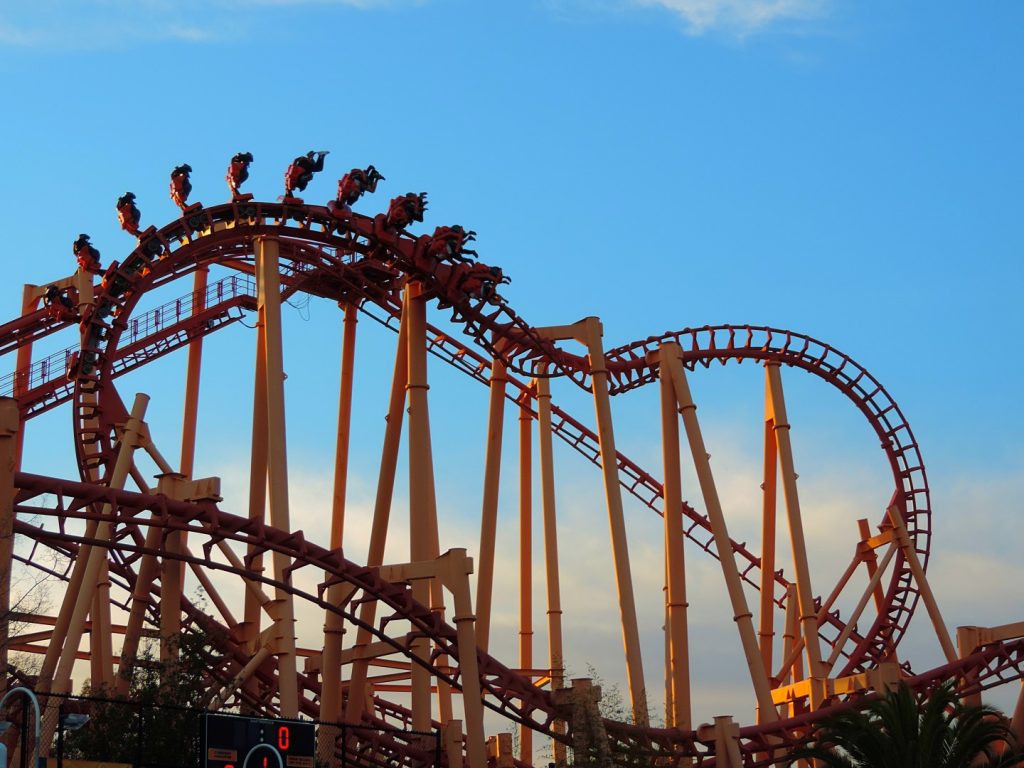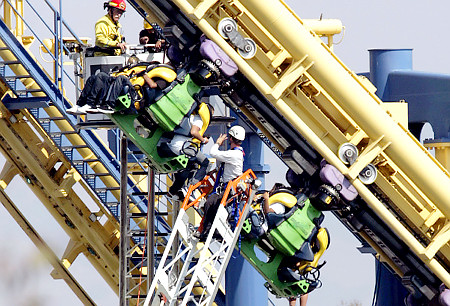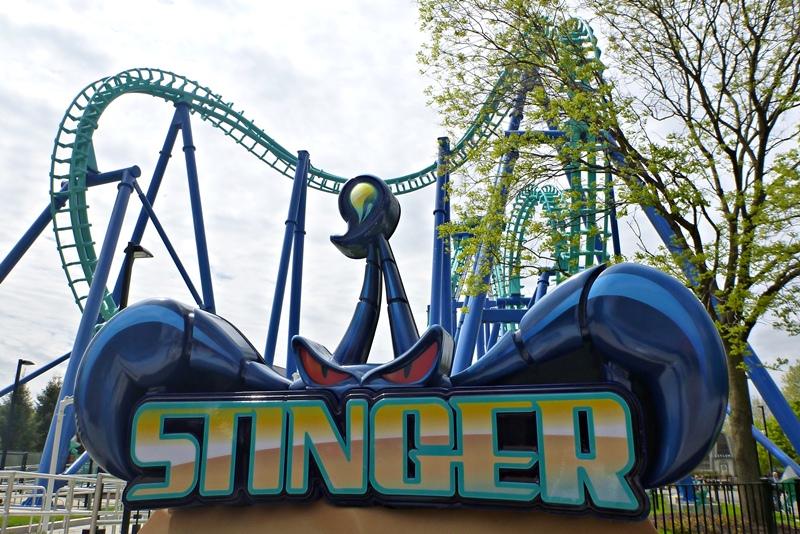Last week we focused on Windjammer Surf Racers and how it was a product of Knott’s Berry Farm’s attempt to navigate the space between the family and thrill market. It faced the problem of Magic Mountain dominating the thrill market with major coaster additions, many of which we’ve discussed here, and Disneyland’s hyper detailed themed experiences. Northern California in the late 90s had a far less competitive theme park market. After the construction and runaway success of Tidal Wave in 1977 Marriott’s Great America, eventually Great America in 1985 and then Paramount’s Great America in 1993, had remained consistent with coaster trends. In 1986 they opened the wooden Grizzly, 1991 saw the addition of the B&M standup Vortex, and 1993 saw the addition of the still-beloved B&M invert Top Gun. These consistent additions, despite changes in ownership, resulted in a solid coaster collection any regional park could be proud of.
– In the past, many of our images have been posted, featured, and shared on forums, social media platforms and websites around the web. We work hard to provide the coverage that we do, and we encourage our audience to share our content and use our images, BUT ONLY IF proper credit is given to thecoasterkings.com. Thank you! –
This article aligns with a special podcast mini-episode! Click the logo below to listen to the podcast!

In 1997 Premier Parks, which would eventually become Six Flags, took over the management of Marine World. Located around an hour north of Great America, Marine World was a well established marine and animal life park which had never focused on rides. Premier immediately sought to change that and for the 1998 season added two Vekoma roller coaster’s to the rechristened “New Marine World Theme Park”(it would simply be renamed Six Flags Marine World the following year). The rebranding for 1998 was a direct statement to Great America, there was a new player in the Northern California theme park market.

Dutch manufacturer Vekoma had made a name for themselves in the 1970s when they entered a longstanding relationship with Arrow Development to manufacture Arrow coasters in Europe. Arrow provided their signature track design and provided Arrow trains to all of Vekoma’s projects. Vekoma took Arrow’s track design and developed a series of successful production models, many of which were portable. This was perfect for the more widespread fair circuit in Europe. In 1985 Arrow Huss filed for bankruptcy leaving several projects unfinished. Vekoma was the natural fit to step in and complete these projects. This bankruptcy also opened the door for Vekoma to properly enter the US market, and they had the perfect product, the boomerang. The first Vekoma boomerang in the US opened in 1984, a year before Arrow’s bankruptcy, as Sea Serpent at Morey’s Pier. This compact shuttle coasters fit six Inversions and two drops(one forward and one backward) into a super tight 935 ft track layout. They are easily the most successful major coaster model of all time and Vekoma continues to manufacture the boomerang with little modification. Ten years after the introduction of the boomerang Vekoma would debut it’s version of the inverted coaster. Dubbed the “suspended looping coaster” or SLC this inverted model offered an inexpensive way for park’s who might not be able to afford a B&M to bring an inverted coaster with 5 inversions to their parks. Both models brought major park thrills at small park prices. Premier’s 1998 package for Marine World included both of these coaster models in the boomerang Boomerang Coast to Coaster and SLC Kong.
After the SLC, Vekoma wanted to continue to expand and experiment with coaster designs. A logical next step was to merge these two coaster models to create the inverted boomerang, or Invertigo model. This model utilizes an almost identical layout to the boomerang but features inverted cars with both forward and backward seats allowing riders to face each other as they run through the course. The prototype Invertigo opened in 1997 at Liseberg in Sweden, after delays surrounding an experimental magnetic launch system resulted in the use of a traditional chain lift. Paramount saw the potential of this compact model and decided to buy it for the landlocked Great America, replacing the beloved Sky Whirl triple ferris wheel. Invertigo premiered at Great America in 1998 and was a success, despite its less than stellar capacity. In 1999 Paramount utilized a second Vekoma Invertigo to bring an inverted coaster named Face/Off to Kings Island. This move made sense as nearby Six Flags Kentucky Kingdom already featured the first Vekoma SLC in the U.S. and B&M’s exclusivity contract meant another inverted coaster couldn’t be built so close to Cedar Point. The final invertigo built by Vekoma would be Two-Face: The Flip Side which opened at Maryland’s Six Flags America in 1999.

Great America’s Invertigo had some mechanical issues but operated well and remained a crowd pleaser. In 2009 there was a malfunction which led to the train being stuck on one of the lift spikes(https://www.mercurynews.com/2009/08/11/great-americas-invertigo-roller-coaster-to-be-closed-two-months/). Unlike previous malfunctions where the train was able to be lowered into the station this malfunction resulted in riders being evacuated by the fire department using a ladder truck. Invertigo was shut down while the incident was investigated. The ride ultimately reopened for the 2010 season but this would prove to be it’s last and the next year it would be relocated to Dorney Park and renamed Stinger where it would operate until 2017.

The removal of Invertigo in 2010 marked a low point for coasters at California’s Great America. With the removal of Greased Lightnin’’(Tidal Wave) in 2002, Stealth in 2003, and Invertigo in 2010 the park went from coaster destination to barely being part of the conversation. It wouldn’t be until the addition of the GCI woodie Gold Striker in 2013 that the park would begin regaining its position as a major theme park. As for the Vekoma Invertigo model, it proved less successful than both the boomerang and the SLC that preceded it. It’s possible that it’s $11 million dollar price tag, nearly double the cost of a boomerang, but relatively low capacity made it out of reach for smaller parks and unappealing to parks who could build a higher capacity Vekoma SLC for about the same price. Vekoma would revisit the concept with a larger model that we will explore later in this series.
Next week I’ll be looking at Paramount’s Great America’s next major coaster addition. Turning again to Vekoma, Paramount decided to take a chance and construct a unique prototype. In 2000 the park would unveil the world’s first large-scale flying roller coaster. Its troubled opening and operations would be a major turning point for this park, setting it on the trend leading to the 2010 removal of Invertigo. Join me for part 9 of the lost coasters of California, Stealth.


